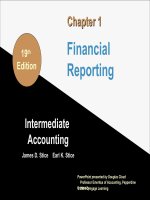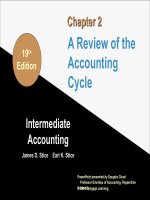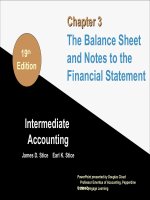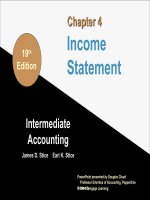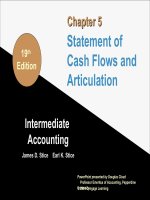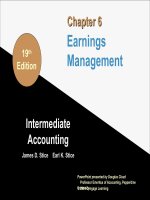Intermediate accounting 19th by stice stice chapter 11
Bạn đang xem bản rút gọn của tài liệu. Xem và tải ngay bản đầy đủ của tài liệu tại đây (323 KB, 77 trang )
19th
Edition
Chapter 11
Investments in
Noncurrent Operating
Assets—Utilization
and Retirement
Intermediate
Accounting
James D. Stice
Earl K. Stice
PowerPoint presented by Douglas Cloud
Professor Emeritus of Accounting, Pepperdine
University
© 2014 Cengage Learning
11-1
What is depreciation?
•
Depreciation is not a process through which
a company accumulates a cash fund to
replace its long-lived fixed assets.
•
Depreciation is not a way to compute the
current value of long-lived assets.
•
Depreciation is the systematic allocation of
the cost of an asset over the different
periods benefited by the use of the asset.
11-2
Factors Affecting the Periodic
Depreciation Charge
Four factors are taken into consideration in
determining the appropriate amount of annual
depreciation expense.
• Asset cost
• Residual or salvage value
• Useful life
• Pattern of use
11-3
Depreciation Vocabulary
•
•
•
Asset cost is the purchase cost plus any
capitalized expenditures.
Residual (salvage) value of property is an
estimate of the amount for which the asset
can be sold when it is retired.
Useful life is the expected life of the asset
in years, hours of service, or per unit of
output.
(continued)
11-4
Useful Life
The physical factors that limit the service life
of an asset are—
1) wear and tear,
2) deterioration and decay, and
3) damage or destruction.
The primary functional factor limiting the
useful life of assets is obsolescence.
11-5
Depreciation Formula Symbols
The examples that follow assume the acquisition
of a polyurethane plastic-molding machine at the
beginning of 2013 by Schuss Boom Ski
Manufacturing, Inc., at a cost of $100,000 with
an estimated residual value of $5,000.
C = Asset cost
R = Estimated residual value
n = Estimated life in years, hours of service, or
units of output
r = Depreciation rate per period, per hour of
service, or per unit of output
D = Periodic depreciation charge
11-6
Time-Factor Methods
Straight-Line
Straight-Line
•
•
•
Of the time-factor methods, straight-line
depreciation is by far the most popular.
Straight-line depreciation relates to the
passage of time and recognizes equal
depreciation in each year of the life of the
asset.
This method assumes the asset is equally
useful during each time period.
(continued)
11-7
Straight-Line Depreciation
Using data for the machine acquired by
Schuss Boom Ski Manufacturing and
assuming a 5-year life, annual depreciation is
computed as follows:
D=
C–R
N
=
$100,000 – $5,000
5 years
= $19,000 per year
(continued)
11-8
Sum-of-the-Years’
Digits Method
The sum-of-the-years’-digits depreciation
method yields decreasing depreciation in
each successive year. To determine the
denominator, use the following formula
(assuming 5 years):
[n (n + 1)]
SYD =
2
[5 (5 + 1)]
SYD =
2
Or, simple add
1+2+3+4+5
SYD = 15
(continued)
11-9
Sum-of-the-Years’
Digits Method
Now that we know the denominator, we can
determine the depreciation for the year using the
following formula, where “t” equals years
remaining at the beginning of the period.
t
× (C – R)
D=
SYD
5
× ($100,000 – $5,000)
D=
15
D = $31,667
(continued)
11-10
Sum-of-the-Years’
Digits Method
For the second year, we reduce the numerator
by one.
t
× (C – R)
D=
SYD
4
× ($100,000 – $5,000)
D=
15
D = $25,333
(continued)
11-11
Declining-Balance Method
•
The declining-balance depreciation
method provides decreasing charges by
applying a constant percentage rate to a
declining asset book value. First, the
constant percentage must be calculated.
•
The most popular rate is two times the
straight-line rate, and this method is called
double-declining balance depreciation.
11-12
Declining-Balance Method
•
•
Or you can use the following formula to get
the straight-line rate: 1/n
Thus, the molding machine would have a
straight-line rate of 20% (1/5). This number
is doubled to arrive at the double-declining
percentage of 40%.
11-13
Factors Suggesting the Use of an
Accelerated Method
1)The anticipation of a significant
contribution in early periods with the
extent of the contribution to be realized
in later periods being less definite.
2)The possibility that inadequacy or
obsolescence may result in premature
retirement of the asset.
11-14
Use-Factor Methods
Use-factor depreciation methods
view asset exhaustion as related
primarily to asset use or output and
provide periodic charges varying with
the degree of such services.
(continued)
11-15
Service-Hours Depreciation
•
The first use-factor method we will
examine is service-hours
depreciation.
•
This method is based on the theory that
the purchase of an asset represents the
purchase of a number of hours of direct
service.
(continued)
11-16
Service-Hours Depreciation
The Schuss Boom Ski Manufacturing
machine costs $100,000 and had a
residual value of $5,000. It is estimated
that the machine will perform for an
estimated service life of 20,000 hours.
Now we can determine the rate to be
applied to each service hour.
(continued)
11-17
Service-Hours Depreciation
D=
C–R
n
=
$100,000 – $5,000
20,000 hours
D = $4.75 per hour
Equals the projected
residual value
11-18
Productive-Output Depreciation
•
Productive-output depreciation is based
on the theory that an asset is acquired for
the service it can provide in the form of
production output.
•
The Schuss Boom asset is estimated to
have a productive life of 25,000 units.
•
Assume the company produced 3,200
units in 2013 and 5,400 units in 2014.
(continued)
11-19
Productive-Output Depreciation
r =
C–R
n
$100,000 – $5,000
=
25,000 units
r = $3.80 per unit
Annual depreciation for 2013 and 2014:
2013: 3,200 units × $3.80 = $12,160
2014: 5,400 units × $3.80 = $20,520
11-20
Group and Composite Depreciation
•
•
•
Group depreciation groups similar assets
into depreciation accounts (e.g., all of a
company’s delivery vans).
Composite depreciation refers to placing
assets in the group that are related but
dissimilar (e.g., all of a company’s desks,
chairs, and computers).
The group depreciation procedure treats a
collection of assets as a single group.
(continued)
11-21
Group and Composite Depreciation
The rate of 12.5%, applied to the cost of
existing assets, $20,000, results in annual
depreciation of $2,500.
(continued)
11-22
Group and Composite Depreciation
Because the accumulated depreciation
account applies to the entire group of assets,
no book value can be calculated for any
specific asset. If asset B were sold for $3,500
after two years, the following entry would be as
follows:
Cash
Accumulated Depreciation
Equipment
6,000
3,500
2,500
No gain or loss is recognized.
11-23
Depreciation and IAS 16
The component approach is required under
IASB standards. The following requirement is
contained in IAS 16:
“Each part of an item of property, plant
and equipment with a cost that is
significant in relation to the total cost
of the item shall be depreciated
separately.”
11-24
Depreciation and Accretion of an
Asset Retirement Obligation
•
Bryan Beach Company purchases and
erects an oil platform at a total cost of
$750,000. Bryan Beach is legally
obligated to dismantle and remove the
platform after 10 years.
•
It is estimated that this will cost $100,000.
Assuming an 8% interest rate, the present
value of the obligation is $46,319 [46.319
(n = 10; i = 8%) × $100,000].
(continued)
11-25


